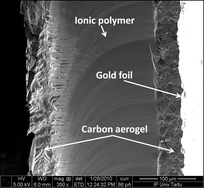Electroactive polymer actuators with carbon aerogel electrodes
Abstract
Electromechanically active

* Corresponding authors
a
IMS Lab, Institute of Technology, University of Tartu, Nooruse 1, Tartu, Estonia
E-mail:
alvo@ut.ee
Web: http://www.ims.ut.ee
b Institute of Chemistry, University of Tartu, Ravila 14a, Tartu, Estonia
c Institute of Chemistry, Tallinn University of Technology, Akadeemia tee 15, Tallinn, Estonia
Electromechanically active

 Please wait while we load your content...
Something went wrong. Try again?
Please wait while we load your content...
Something went wrong. Try again?
V. Palmre, E. Lust, A. Jänes, M. Koel, A. Peikolainen, J. Torop, U. Johanson and A. Aabloo, J. Mater. Chem., 2011, 21, 2577 DOI: 10.1039/C0JM01729A
To request permission to reproduce material from this article, please go to the Copyright Clearance Center request page.
If you are an author contributing to an RSC publication, you do not need to request permission provided correct acknowledgement is given.
If you are the author of this article, you do not need to request permission to reproduce figures and diagrams provided correct acknowledgement is given. If you want to reproduce the whole article in a third-party publication (excluding your thesis/dissertation for which permission is not required) please go to the Copyright Clearance Center request page.
Read more about how to correctly acknowledge RSC content.
 Fetching data from CrossRef.
Fetching data from CrossRef.
This may take some time to load.
Loading related content
